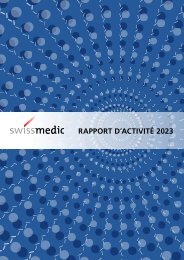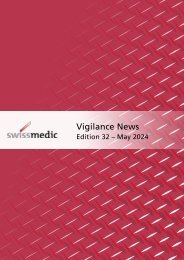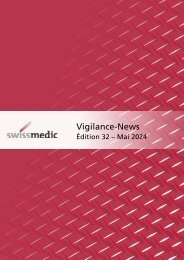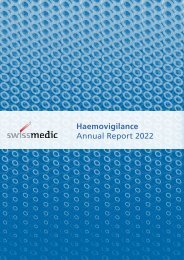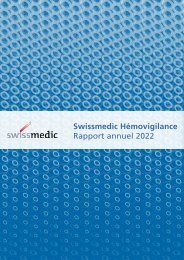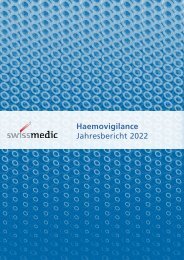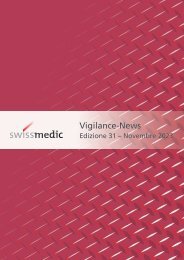Swissmedic Vigilance-News Edition 30 – Mai 2023
In dieser Ausgabe: • Immuncheckpoint-Inhibitoren: schwangerschaftsbezogene Outcomes • JAK-Inhibitoren: Massnahmen zur Risikominimierung / Individualisierte Dosierung • COVID-19-Impfstoffe: Myokarditis bei älteren Patienten / Unerwünschte Wirkungen nach Impfung mit bivalenten Impfstoffen • Haemovigilance: Fehltransfusionen und Beinahe-Fehler
In dieser Ausgabe:
• Immuncheckpoint-Inhibitoren: schwangerschaftsbezogene Outcomes
• JAK-Inhibitoren: Massnahmen zur Risikominimierung / Individualisierte Dosierung
• COVID-19-Impfstoffe: Myokarditis bei älteren Patienten / Unerwünschte Wirkungen nach Impfung mit bivalenten Impfstoffen
• Haemovigilance: Fehltransfusionen und Beinahe-Fehler
Create successful ePaper yourself
Turn your PDF publications into a flip-book with our unique Google optimized e-Paper software.
SHOT (Serious Hazards of Transfusion) <strong>–</strong> siehe<br />
Tabelle 1 (3). Ein Transfusionsfehler kann an jedem<br />
Punkt der Transfusionskette verursacht werden: bei<br />
der Bestellung des Blutprodukts, der Entnahme der<br />
Blutprobe, der Laboranalyse, der Freigabe des Produkts<br />
oder der Transfusion selbst. Die Fehlermeldungen<br />
enthalten zur Analyse daher Angaben zu<br />
Ursache, Art der Abweichung (z. B. Kommunikation,<br />
Dokumentation, technischer Fehler) sowie zu<br />
Fehlerentdeckung und getroffenen Massnahmen.<br />
In Bezug auf den Schweregrad werden IBCT- und<br />
NM-Ereignisse nach ihrem Schadenspotential oder <strong>–</strong><br />
im Falle von NM <strong>–</strong> auch ihrem Verwechslungspotential<br />
eingestuft. Ausführliche Erläuterungen zur<br />
Einteilung und weitere Beispiele sind im «Haemovigilance<br />
Jahresbericht 2021» zu finden (Rubrik<br />
«Publikationen & Veranstaltungen» der Website<br />
swissmedic.ch).<br />
Tabelle 1: IBCT-Klassifikationen analog SHOT (3)<br />
Wrong component transfused (WCT)<br />
Cases in which a patient was transfused with a blood product different from the one prescribed (e.g. platelets instead of RBC), in which<br />
the blood product was of an incorrect blood group or was intended for another patient (and was ABO/RhD incompatible), or where the<br />
blood product was transfused to another patient and was compatible by chance.<br />
Specific requirements not met (SRNM)<br />
Cases in which the transfused blood component did not meet the required specifications because of an error (e.g. irradiated products or<br />
HLA-matched platelets when indicated). If the deviation is the result of a deliberate clinical decision (e.g. because of an emergency<br />
situation) it is not considered an SRNM (one exception here is the deliberate administration of Rhesus D-positive blood to Rhesus D-<br />
negative recipients in the context of a mass transfusion <strong>–</strong> this situation should be reported).<br />
Handling and storage errors (HSE)<br />
Cases in which a blood product is selected and tested correctly, but its quality or safety are compromised due to errors in handling or<br />
storage (e.g. interruption of the cold chain, incorrect thawing of plasma, shelf life exceeded).<br />
Avoidable, delayed or under-/over-transfusion (ADU)<br />
ADU is the term used to describe errors in the quantity and timing of transfusions:<br />
Avoidable transfusions: Transfusions in which the indication was incorrect, e.g. due to incorrect laboratory results (such as false low<br />
haemoglobin or platelet values), errors in transmitting results or incorrect clinical decisions. The term also covers the avoidable use of<br />
emergency products (0 RhD neg).<br />
Delayed transfusions: Clinically indicated transfusions, which were not given or were given with a relevant delay. These include, for example,<br />
the delayed provision of blood products in an emergency situation with relevant delays in patient care (e.g. rescheduling of surgery)<br />
Over-/under-transfusion: Transfusion of too large or too small a quantity of a product, e.g. due to incorrect prescription or the malfunction<br />
of an infusion pump.<br />
Right blood, right patient (RBRP)<br />
Incidents in which the transfusion was correct but there were relevant errors in identifying or prescribing the blood products. These include,<br />
for example, damaged or incomplete labelling, a missing patient ID bracelet, a missing official prescription or missing signatures.<br />
<strong>Swissmedic</strong> <strong>Vigilance</strong>-<strong>News</strong> | <strong>Edition</strong> <strong>30</strong> <strong>–</strong> <strong>Mai</strong> <strong>2023</strong><br />
33




